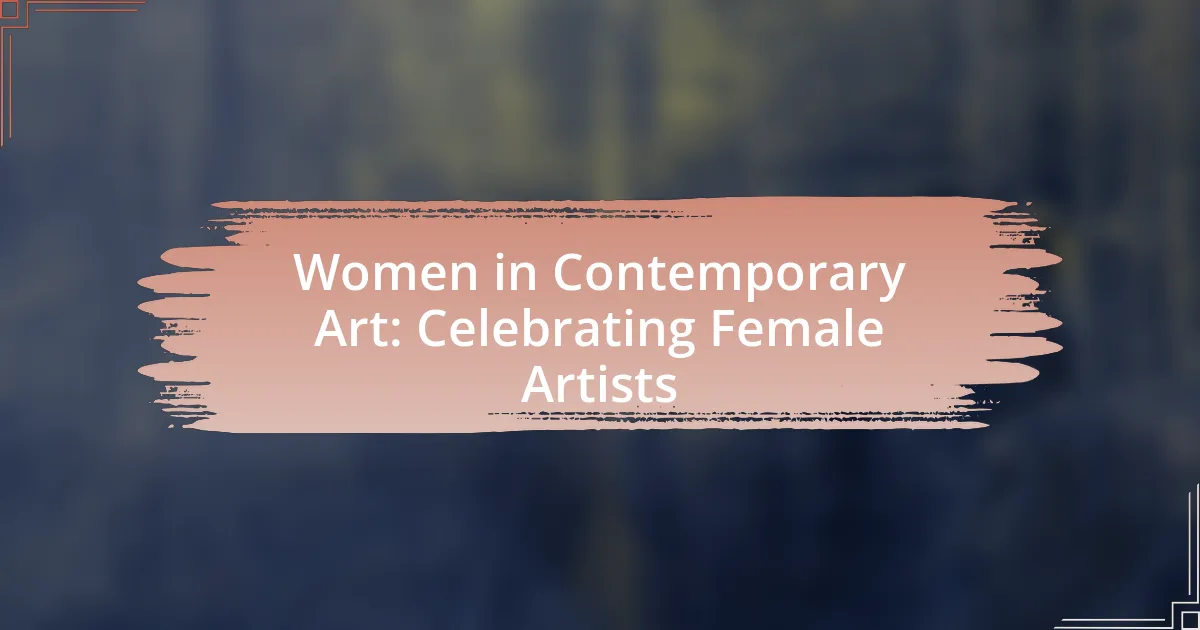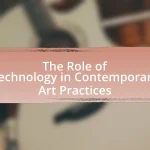The article focuses on the significance of women in contemporary art, highlighting their crucial role in challenging traditional narratives and expanding artistic expression. It discusses the increasing representation of female artists in major exhibitions and collections, the influence of key movements such as the Feminist Art Movement, and the challenges women face in the art scene, including gender bias and underrepresentation. Additionally, the article emphasizes the importance of celebrating female artists to promote gender equality and recognizes notable figures like Yayoi Kusama and Kara Walker, whose works address themes of identity and social justice. It also outlines initiatives and organizations dedicated to supporting women in the arts, advocating for greater visibility and recognition in the art market.
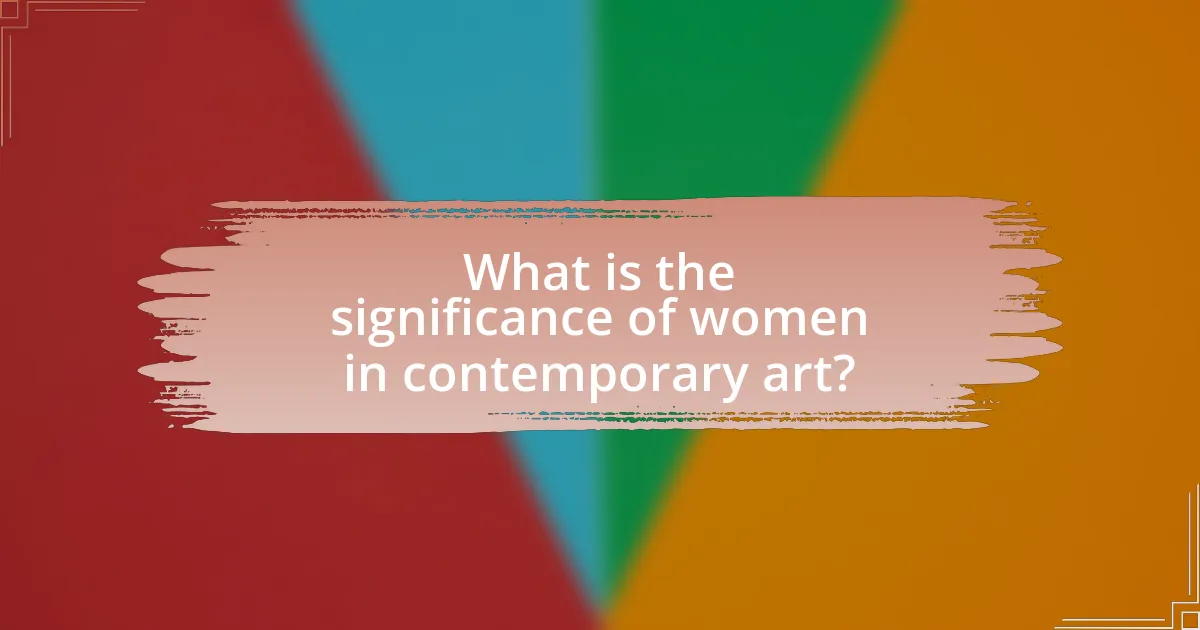
What is the significance of women in contemporary art?
Women play a crucial role in contemporary art by challenging traditional narratives and expanding the scope of artistic expression. Their contributions have led to a more inclusive understanding of art, as evidenced by the increasing representation of female artists in major exhibitions and collections, such as the Venice Biennale, where female participation has risen significantly over the past decade. Furthermore, studies indicate that artworks created by women often address themes of identity, gender, and social justice, thereby enriching the dialogue within the art world. This shift not only highlights the importance of diverse perspectives but also reflects broader societal changes regarding gender equality and representation in the arts.
How have female artists influenced the art world today?
Female artists have significantly influenced the art world today by challenging traditional narratives and expanding the scope of artistic expression. Their contributions have led to increased visibility and representation of diverse perspectives in contemporary art. For instance, artists like Yayoi Kusama and Kara Walker have utilized their platforms to address issues such as mental health and racial identity, respectively, thereby reshaping public discourse around these topics. Additionally, the rise of feminist art movements has prompted institutions to reevaluate their collections and exhibitions, resulting in a more inclusive approach that recognizes the work of women artists. This shift is evidenced by the growing number of exhibitions dedicated to female artists, such as the 2019 “Women Artists: 1550-1950” at the National Gallery in London, which highlighted the historical contributions of women in art.
What are some key movements led by female artists?
Key movements led by female artists include the Feminist Art Movement, which emerged in the 1970s, advocating for women’s rights and representation in the art world. This movement was characterized by artists like Judy Chicago and Miriam Schapiro, who created works that challenged traditional gender roles and highlighted women’s experiences. Another significant movement is the Women’s Art Movement, which focused on creating spaces for female artists and promoting their work, exemplified by initiatives such as the Womanhouse project in 1972. Additionally, the Riot Grrrl movement in the 1990s combined punk music and feminist ideology, with artists like Kathleen Hanna using art to address issues of female empowerment and social justice. These movements collectively transformed the landscape of contemporary art, emphasizing the importance of female perspectives and contributions.
How do female artists challenge traditional art narratives?
Female artists challenge traditional art narratives by subverting established themes, techniques, and perspectives that have historically marginalized their voices. They often address issues such as gender, identity, and social justice, thereby reshaping the discourse around art. For example, artists like Judy Chicago and her installation “The Dinner Party” confront the male-dominated art canon by celebrating women’s contributions to history and culture. Additionally, contemporary artists like Kara Walker use provocative imagery to critique racial stereotypes and the legacy of slavery, further challenging conventional narratives. This active engagement with societal issues not only redefines artistic expression but also expands the understanding of what constitutes art, making it more inclusive and reflective of diverse experiences.
Why is it important to celebrate female artists?
Celebrating female artists is important because it promotes gender equality and recognizes the significant contributions women have made to the art world. Historically, female artists have been underrepresented and often overlooked in art history, with only 3% of artworks in major museums attributed to women. Acknowledging their work not only empowers these artists but also inspires future generations, fostering a more inclusive and diverse cultural landscape. Celebrating female artists helps to challenge stereotypes and dismantle barriers, ultimately enriching the art community and society as a whole.
What impact does recognition have on female artists’ careers?
Recognition significantly enhances female artists’ careers by increasing their visibility and opportunities within the art world. When female artists receive recognition, such as awards, exhibitions, or media coverage, it often leads to greater access to galleries, collectors, and funding. For instance, a study by the National Museum of Women in the Arts found that female artists who are recognized in major exhibitions see a 50% increase in sales and representation in galleries. This recognition not only validates their work but also helps to challenge the historical underrepresentation of women in the art market, fostering a more equitable environment for future generations of female artists.
How does celebrating female artists contribute to gender equality in the arts?
Celebrating female artists contributes to gender equality in the arts by increasing visibility and recognition of their work, which historically has been marginalized. When female artists are celebrated, it challenges the gender biases that have led to underrepresentation in galleries, exhibitions, and art history. For instance, a study by the National Museum of Women in the Arts found that only 11% of artists in major U.S. museums are women, highlighting the need for increased representation. By promoting female artists, the art community fosters a more inclusive environment that encourages diverse perspectives and narratives, ultimately leading to a more equitable art world.
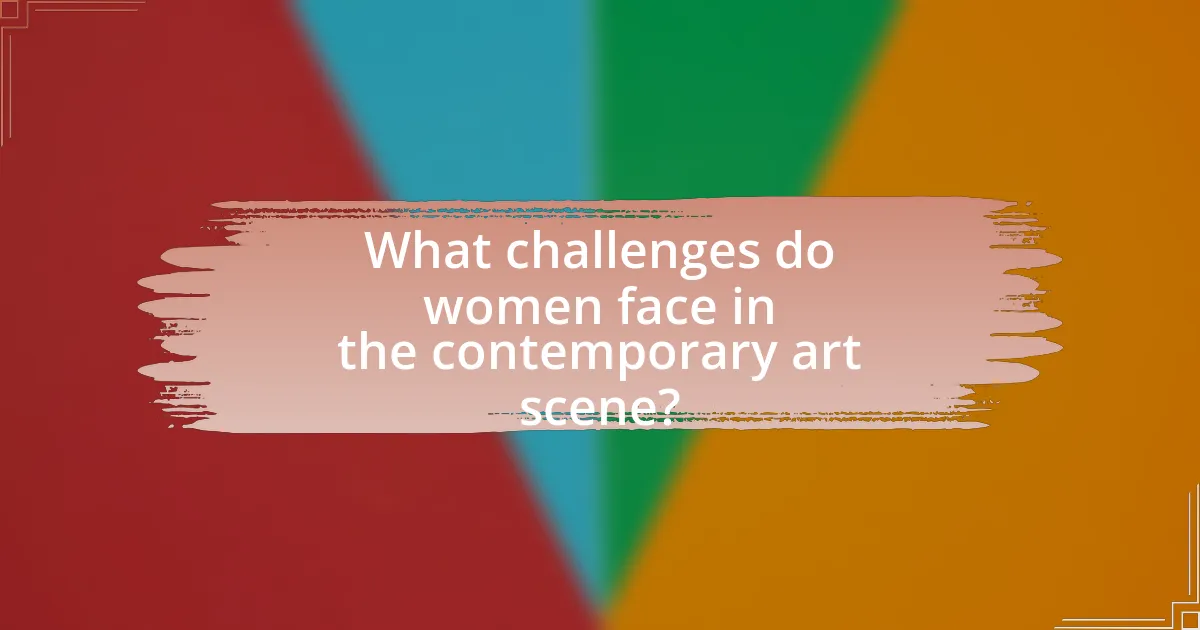
What challenges do women face in the contemporary art scene?
Women in the contemporary art scene face significant challenges, including gender bias, underrepresentation, and unequal access to opportunities. Research indicates that female artists receive less exhibition space and funding compared to their male counterparts; for instance, a study by the National Museum of Women in the Arts found that only 11% of artists represented in major galleries are women. Additionally, women often encounter systemic barriers in networking and mentorship, which can hinder their career advancement. These factors contribute to a persistent gender gap in recognition and sales within the art market, further complicating the landscape for female artists.
How do societal perceptions affect female artists?
Societal perceptions significantly impact female artists by influencing their visibility, opportunities, and the reception of their work. For instance, research indicates that female artists often face biases that can limit their representation in galleries and exhibitions, with studies showing that only 30% of artists represented in major galleries are women. This disparity reflects a broader societal tendency to undervalue women’s contributions in the arts, which can lead to reduced funding and support for female-led projects. Furthermore, societal stereotypes about gender roles can shape the themes and styles that female artists feel pressured to adopt, often pushing them towards more traditionally feminine subjects. This dynamic not only affects their artistic expression but also the critical and commercial success of their work, as seen in the lower prices and less media coverage compared to their male counterparts.
What barriers exist for women in gaining visibility in the art market?
Barriers for women in gaining visibility in the art market include systemic gender bias, lack of representation in galleries, and unequal access to funding and resources. Systemic gender bias manifests in the underrepresentation of female artists in exhibitions and collections, with studies indicating that only 30% of artists represented in major galleries are women. Additionally, women often face challenges in networking opportunities and mentorship, which are crucial for career advancement. Research by the National Museum of Women in the Arts highlights that female artists receive significantly less media coverage compared to their male counterparts, further diminishing their visibility. These factors collectively hinder women’s ability to establish a prominent presence in the art market.
How do issues of representation manifest in galleries and exhibitions?
Issues of representation in galleries and exhibitions manifest through the underrepresentation of female artists and the lack of diversity in exhibited works. Research indicates that women artists receive significantly less exhibition space compared to their male counterparts; for instance, a study by the National Museum of Women in the Arts found that only 11% of artists in major exhibitions are women. This disparity highlights systemic biases within the art world that prioritize male artists, leading to a skewed perception of artistic value and contribution. Additionally, the selection processes for exhibitions often favor established male artists, further marginalizing female voices and perspectives. This lack of representation not only affects the visibility of women artists but also influences the narratives and dialogues within contemporary art, reinforcing gender stereotypes and limiting the scope of artistic expression.
What initiatives support women in contemporary art?
Initiatives that support women in contemporary art include organizations like the Guerrilla Girls, which advocate for gender equality in the art world, and the Women’s Caucus for Art, which promotes the visibility of women artists. Additionally, grants such as the Elizabeth Foundation for the Arts’ EFA Studio Program provide resources and opportunities specifically for female artists. These initiatives are crucial in addressing the historical underrepresentation of women in the art sector, as evidenced by statistics showing that only 11% of artists in major museums are women.
Which organizations are dedicated to promoting female artists?
Organizations dedicated to promoting female artists include the National Museum of Women in the Arts, which focuses on showcasing the contributions of women in the visual arts, and the Women’s Caucus for Art, which advocates for women artists and promotes their work through exhibitions and educational programs. Additionally, the Guerrilla Girls, an anonymous group of feminist artists, raises awareness about gender and racial inequality in the art world. These organizations actively support female artists through various initiatives, exhibitions, and advocacy efforts, reinforcing their commitment to gender equality in the arts.
How do mentorship programs benefit emerging female artists?
Mentorship programs benefit emerging female artists by providing guidance, networking opportunities, and skill development. These programs connect artists with experienced mentors who can offer personalized advice, share industry insights, and help navigate challenges specific to women in the arts. Research indicates that mentorship can significantly enhance career advancement; for instance, a study by the National Endowment for the Arts found that artists with mentors are more likely to secure exhibitions and funding. Additionally, mentorship fosters a supportive community, which is crucial for overcoming barriers in a predominantly male-dominated field.
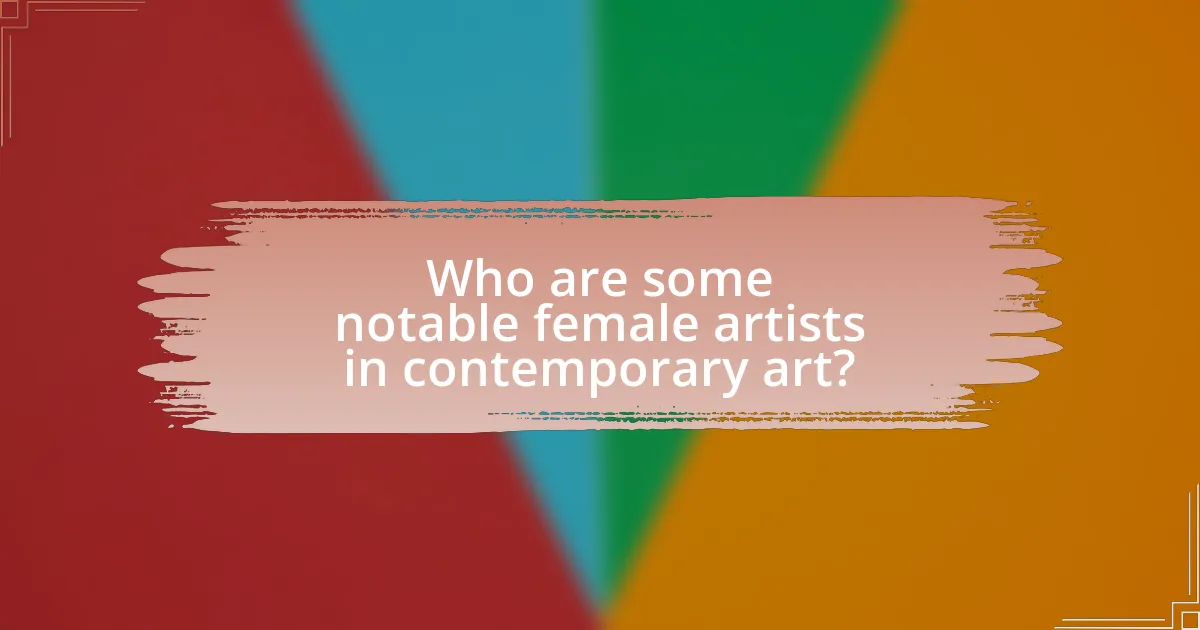
Who are some notable female artists in contemporary art?
Notable female artists in contemporary art include Yayoi Kusama, known for her immersive installations and polka dot motifs; Cindy Sherman, recognized for her conceptual self-portraits that explore identity; and Kara Walker, acclaimed for her provocative silhouettes addressing race and gender. These artists have significantly influenced the art world, with Kusama’s work featured in major exhibitions globally, Sherman receiving the MacArthur Fellowship, and Walker’s installations being displayed in prominent museums like the Tate Modern. Their contributions reflect diverse perspectives and have garnered critical acclaim, solidifying their status in contemporary art.
What are the contributions of specific female artists to contemporary art?
Specific female artists have significantly shaped contemporary art through innovative practices and thematic explorations. For instance, Yayoi Kusama’s immersive installations and polka dot motifs challenge perceptions of infinity and self-identity, making her a pivotal figure in contemporary art. Similarly, Cindy Sherman’s photography critiques gender roles and identity, using her own image to explore societal constructs. Additionally, Kara Walker’s silhouettes address race and history, provoking dialogue on the complexities of African American experiences. These artists not only expand the boundaries of artistic expression but also influence cultural conversations, demonstrating the vital role of women in contemporary art.
How have artists like Yayoi Kusama and Tracey Emin shaped modern art?
Yayoi Kusama and Tracey Emin have significantly shaped modern art through their unique approaches to self-expression and exploration of personal themes. Kusama’s use of polka dots and immersive installations challenges perceptions of infinity and mental health, while Emin’s confessional art, particularly in works like “My Bed,” confronts issues of femininity, trauma, and sexuality. Both artists have pushed boundaries, encouraging a more inclusive dialogue in contemporary art that embraces vulnerability and personal narrative, thereby influencing a generation of artists to explore their identities and experiences.
What themes do these artists explore in their work?
These artists explore themes of identity, empowerment, and social justice in their work. For instance, many female artists address the complexities of gender and race, reflecting personal experiences and societal issues. Artists like Frida Kahlo and Yayoi Kusama have used their art to challenge traditional narratives and express their unique perspectives, thereby contributing to broader conversations about feminism and representation in the art world. Their works often serve as a critique of patriarchal structures, highlighting the importance of women’s voices in contemporary discourse.
How do diverse backgrounds influence female artists’ work?
Diverse backgrounds significantly influence female artists’ work by shaping their perspectives, themes, and techniques. Female artists from various cultural, ethnic, and socioeconomic backgrounds often draw upon their unique experiences to inform their artistic expression, resulting in a rich tapestry of narratives that reflect their identities. For instance, artists like Frida Kahlo, who incorporated her Mexican heritage and personal struggles into her work, demonstrate how cultural context can lead to distinctive artistic styles and messages. Additionally, research indicates that diversity in artistic backgrounds fosters innovation and creativity, as artists bring different viewpoints and methodologies to their practice, enhancing the overall landscape of contemporary art.
What role does cultural identity play in the art of female artists?
Cultural identity significantly influences the art of female artists by shaping their perspectives, themes, and expressions. Female artists often draw from their cultural backgrounds to explore issues such as gender, race, and social justice, which are reflected in their work. For instance, artists like Frida Kahlo and Yayoi Kusama incorporate elements of their cultural heritage and personal experiences into their art, creating a unique narrative that resonates with diverse audiences. This connection to cultural identity not only enriches their artistic expression but also fosters a dialogue about the intersectionality of identity in contemporary society.
How do intersectional experiences shape artistic expression?
Intersectional experiences shape artistic expression by influencing the themes, perspectives, and techniques that artists employ in their work. Artists who navigate multiple identities—such as race, gender, sexuality, and class—often reflect these complexities in their art, creating a richer narrative that resonates with diverse audiences. For instance, the work of artists like Frida Kahlo and Kara Walker illustrates how personal and cultural histories inform their artistic choices, allowing them to address social issues and challenge dominant narratives. This intersectionality not only enhances the depth of their art but also fosters a broader understanding of the human experience, as evidenced by the increasing recognition of diverse voices in contemporary art exhibitions and collections.
What can we do to support female artists today?
To support female artists today, we can actively promote their work through dedicated platforms and initiatives. For instance, organizations like the National Museum of Women in the Arts focus on showcasing female artists and their contributions to the art world. Additionally, purchasing art from female artists directly supports their careers and helps to address the gender pay gap in the industry, where female artists often earn less than their male counterparts. According to a 2020 report by ArtNet, female artists sold for an average of 47% less than male artists at auction. By advocating for equal representation in galleries and exhibitions, we can further enhance visibility and opportunities for female artists.
How can art collectors and institutions promote female artists?
Art collectors and institutions can promote female artists by actively acquiring and exhibiting their works, thereby increasing visibility and recognition. For instance, the National Museum of Women in the Arts in Washington, D.C., focuses exclusively on female artists, showcasing their contributions and elevating their status in the art world. Additionally, collectors can support female artists by providing grants and funding opportunities, which have been shown to enhance their career trajectories. According to a study by the Art Basel and UBS Global Art Market Report, female artists represented only 11% of auction sales in 2020, highlighting the need for targeted efforts to balance representation. By prioritizing female artists in their collections and programming, art collectors and institutions can significantly impact the market and cultural landscape.
What actions can individuals take to advocate for gender equality in the arts?
Individuals can advocate for gender equality in the arts by actively supporting female artists through purchasing their work, promoting their exhibitions, and sharing their stories on social media platforms. Research indicates that female artists receive significantly less representation in galleries and exhibitions, with only 11% of artists in major exhibitions being women, according to a 2019 study by the National Museum of Women in the Arts. By attending events featuring female artists, participating in discussions about gender equity in the arts, and encouraging institutions to prioritize diversity in their programming, individuals can contribute to a more equitable art landscape.
